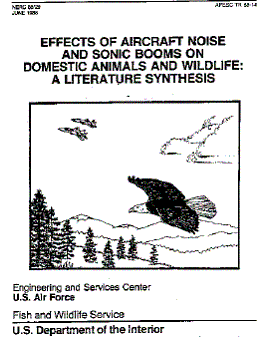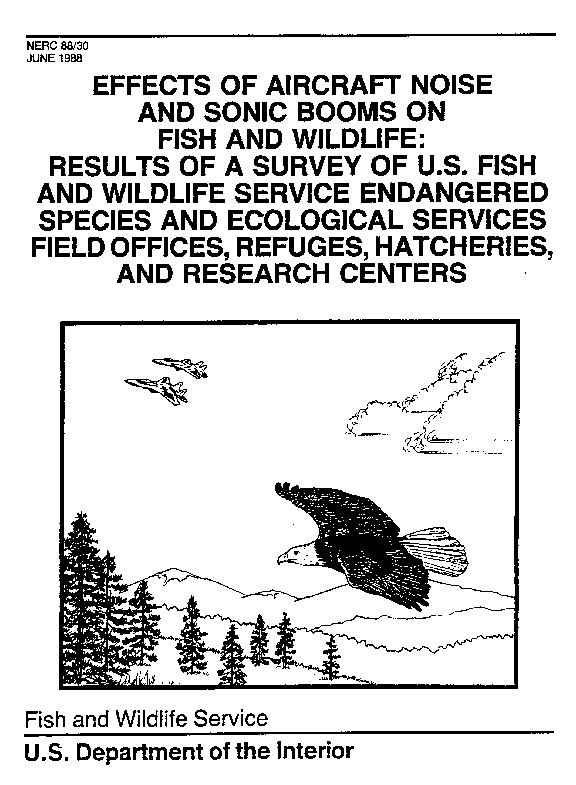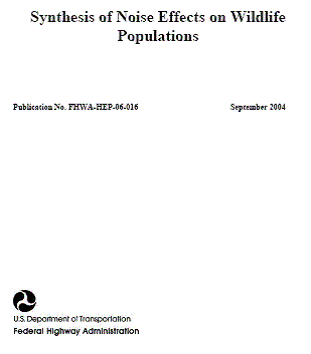
Bob Simonson, Program Leader |
||

San Dimas Technology
& Development Center
444 E Bonita Ave
San Dimas, CA 91773
(909) 599-1267
![]() Literature Search - Effects of Noise on Wildlife
Literature Search - Effects of Noise on Wildlife
Rey Farve, Project Leader
The information provided below is intended to be a collection of pertinent bibliographies and literature syntheses of noise - wildlife impacts. It is not intended to be an exhaustive search on the topic.
Several bibliographies, recent and past, supply summaries of the literature relative to effects of noise on wildlife. Brown (2001) and Radle (2007) provide a general overview of much of the research that exist on the subject. Brown (2001) provides a discussion of the general focus and shortcomings of previous research, as well as, questions that are yet unanswered. Radle (2007) provides an decade-by-decade - from the 1970 through the 1990's - summary of the objectives of many of the key studies and reports relative to noise-wildlife effects. The reader that is interested in this subject is encouraged to read these two summaries to get a "big picture" perspective of the scope of the literature that exist, before delving into the bibliographies cited below.
1970's
EPA provided one of the earliest bibliographies on noise – wildlife impacts (Fletcher 1971). That report was followed up by a report 9 years later by Dufor (1980). Both reports summarize the literature (at the time of publication) on the effects of noise on laboratory animals, domestic animals and wildlife.
 |
 |
Bibliographies by EPA in 1971 & 1980. |
|
1980's
To address concerns of noise impacts from activities of the US Air Force (especially aircraft noise and sonic booms), the US Fish & Wildlife Service and US Air Force jointly published a "literature synthesis" to serve as an information base to assess potential impacts (Manci et al. 1988). The USFWS also conducted a survey in January 1987 that utilized input from many of its field offices, refuges, hatcheries and research centers on the perceived impact of military aircraft noise on wildlife on their locations. The results of that survey were published under Gladwin et al. (1988).
 |
 |
Reports US Fish & Wildlife Service in 1988 |
|
1990's
The impact of noise from military operations on wildlife began to get much attention in the mid-1980's through the 1990's. Larkin et al. (1996) summarizes much of the pertinent literature on noise associated with military training activities (especially from military vehicles, artillery, small-arms, and helicopters) on wildlife. Pertinent noise information from civilian activities (e.g., helicopters, OHVs, hunting) was also included in the literature search.
The National Parks Overflights Act of 1987 (Public Law 100-91) required the US National Park Service to complete a report to the US Congress on the effects of overflights (especially low-level overflights by military aircraft and commercial overflights relative to tourism) on the National Park System. The Law required the US Forest Service to report on the effects of overflights on lands within its wilderness system.
Chapter 5 of the National Park Service's report (NPS 1995) has a comprehensive summary of "Effects of Overflights on Wildlife". This chapter contains a summary of literature relative to wildlife - overflight effects, especially as they relate to: physiological and behavioral responses, indirect effects, habitat avoidance and abandonment, and Threatened and Endangered Species.
Note: NPS' Natural Sounds Program generated an annotated bibliography on the "Impact of Noise and Overflights on Wildlife" (NPS, no date).
The US Forest Service's Report (USFS 1992, Chapter 4) also contains a brief summary of overflight noise - wildlife effects as reported in the literature.
 |
 |
USFS & NPS reports to Congress |
|
Bowles (1995) provides a detailed review of "Responses of Wildlife to Noise". That discussion emphasized studies supported by empirical evidence and downplays studies not supported by experiments or unsuppoted speculations and circumstantial evidence. The review provides details on the effects of noise on auditory physiology and sensory perception, on behavior, and on populations.
2000's
Efroymson et al. (2000) performed an "ecological risk assessment" for the military relative to the risk to wildlife associated with low-altitude overflights. Chapter 4 of the assessment provides a detailed literature review of low-altitude flight noise exposure and response of wildlife (raptors, waterfowl, ungulates, small mammals, reptiles/amphibians, and marine mammals).
In 2004 the Federal Highway Administration (FHA) published a "Synthesis of Noise Effects on Wildlife Populations" (FHA 2004). The report provides a review of some of the current research relative to noise-wildlife impacts, especially noise alongside roads.
 |
FHA noise effects publication |
In 2005, Imperial Oil Resources Ventures Limited had an "Effects of Noise on Wildlife" report (AMEC Americas Limited 2005) produced to provide an overview of existing information on the potential effects of noise on wildlife from activities associated with their Mackenzie Gas Project. (The Mackenzie Gas Project is a proposed 760 mile natural gas pipeline system along the Mackenzie Valley of Canada's Northwest Territories.) The report provides a synthesis of information on the direct and indirect effects of noise generated by activities associated with the construction and operation of oil and gas (especially natural gas) on wildlife (including caribou, moose, bear, marten, lynx, shorebirds/waterfowl, and raptors).
Finally, for the most recent information/research on noise - wildlife impacts, the reader might visit the Acoustic Ecology Institute's website. The Institute's webpage provides information on recently released research dealing with soundscape (i.e., the natural and human generated sound of an area).
Literature Cited
AMEC Americas Limited. 2005. Effects of Noise on Wildlife: Mackenzie Gas Project. Prepared for Imperial oil Resources Ventures Limited. July 2005.
Bowles, A.E. 1995. Response of wildlife to noise. Pages 109-156. In. Knight, R.L. and Gutzwiller (eds.) Wildlife and recreationist: coexistence through management and research. Island Press: Washington, D.C. 372pp.
Brown, L. 2001. Overview of research on effects of noise on wildlife. Pages 10-13. In. Baker, M. and Belliveau, G. (eds.) Effects of noise on wildlife conference, Proceedings. Happy Valley - Goose Bay, Labrador. Aug. 22-23, 2000. Institute for Environmental Monitoring and Research.
Dufor, P. A. 1980. Effects of noise on wildlife and other animals: Review of research since 1971. USEPA, Office of Noise Abatement & Control. Washington, D.C. Dec. 31, 1971. EPA 550/9 BO-100.
Efroymson, R.A., Rose, R.A., Nemeth, S., and Suter II, G.W. 2000. Ecological risk assessment framework for low-altitude overflights by fixed-wing and rotary-wing military aircraft. ORNL/TM-2000/289. ES-5048.
Federal Highway Administration (FHA). 2004. Synthesis of noise effects on wildlife populations. US Dept. Transportation, FHA. # FHWA-HEP-06-016.
Fletcher, J.L. 1971. Effects of noise on wildlife and other animals. USEPA, Office of Noise Abatement & Control. Washington, D.C. Dec. 31, 1971. NTID 30O.5.
Gladwin, D.N., Asherin, D.A and Manci, K.M. 1988. Effects of aircraft noise and sonic booms on fish and wildlife: Results of a survey of U.S. Fish and Wildlife Service endangered species and ecological services field offices, refuges, hatcheries, and research centers. NERC-88/30. USFWS, National Ecology Research Center, Fort Collins, CO.
Larkin, R.P., Pater, L.L., and D.J. Tazik, D.J. 1996. Effects of military noise on wildlife: A literature review. USACERL Technical Report 96/21, January 1996.
Manci, K.M., Gladwin, D.N., Villella, R. and M.G. Cavendish, 1988. Effects of aircraft noise and sonic booms on domestic animals and wildlife: A literature synthesis. U.S. Fish and Wildlife Service. National Ecology Research Center, Ft. Collins, CO NERC-88/29. 88 pp.
National Park Service (NPS). 1995. Report on effects of aircraft overflights on the National Park System: Report to Congress. Washington, DC.
NPS. no date. Impacts of Noise and overflights on wildlife: annotated bibliography. National Park Service, Natural Sounds Program center. 32pp. Downloaded from NPS site on 29 Sep 2008 at http://www.nature.nps.gov/naturalsounds/publications/wildlifebiblio.pdf
Radle, A.L. 2007. The Effects of Noise on Wildlife: A Literature Review. Report Date: 3/2/2007. 16pp. Downloaded on 29 September 2008 from: (http://interact.uoregon.edu/MediaLit/wfae/library/articles/radle_effect_noise_wildlife.pdf)
US Forest Service (USFS). 1992. Report to Congress: Potential Impacts of Aircraft Overflights of National Forest System Wildernesses.
